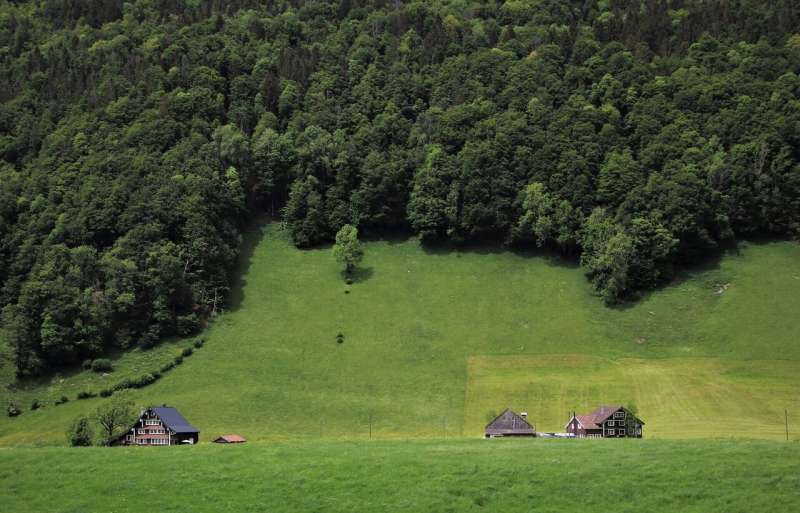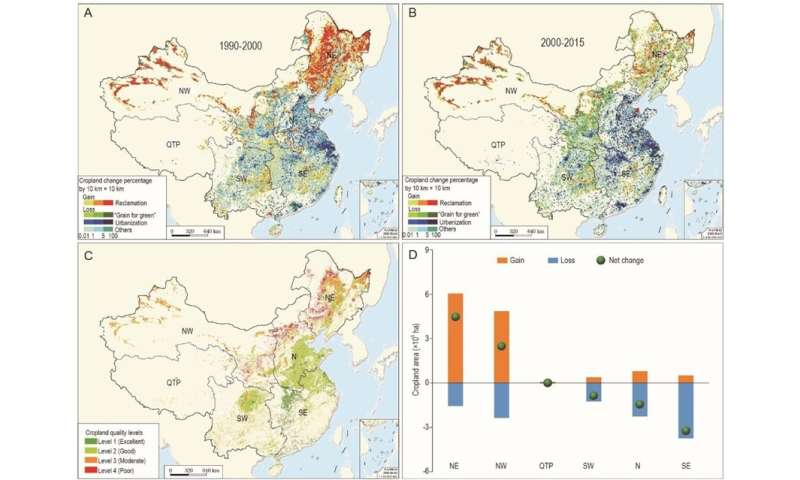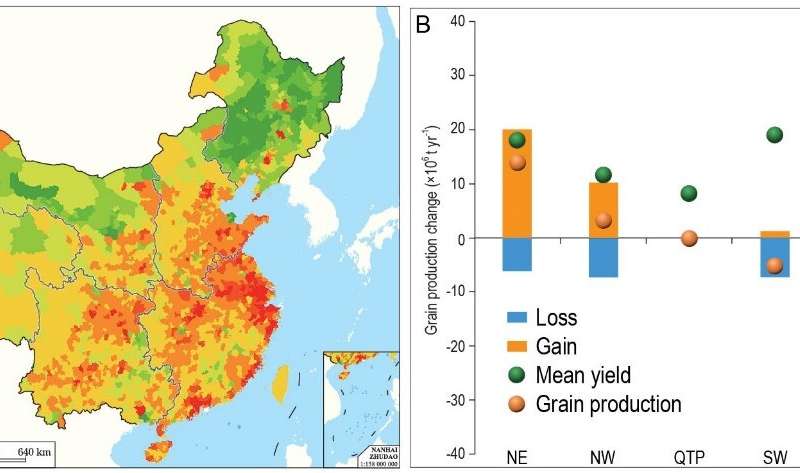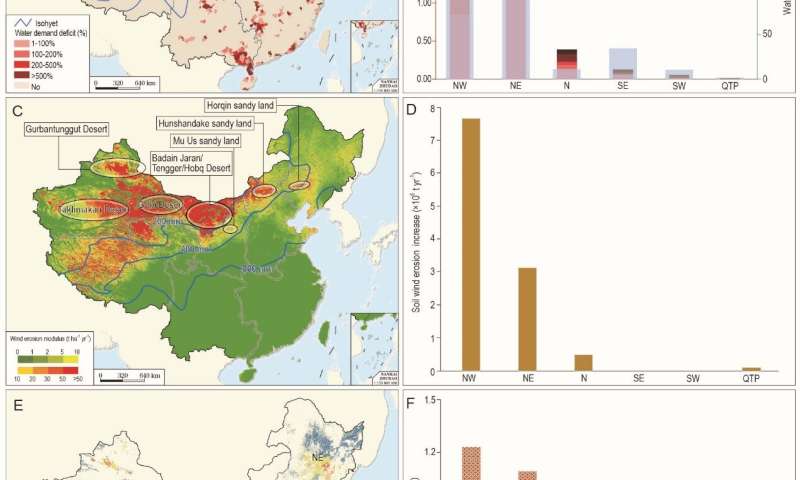A hidden driver of food insecurity and environmental crisis

The cultivated planet is withstanding record-breaking pressure to ensure food security. To meet the rising demand of food, energy, and fiber, a 70%-100% increase in crop commodities will be needed globally by 2050. However, rapid urbanization and industrialization have caused dramatic loss of high-quality cropland and hence threatened food security. To stabilize cropland area, cropland expansion to marginal lands has become a widespread phenomenon worldwide. This study developed a systems framework to represent the trade-off among crop yield, production, and environmental cost, according to the competitive relationship of production, settlement, and ecological space and the link of "land—food—environment—policy". Using China as a case study, the authors validated the systems framework by assessing the associated food benefits and environmental costs from large-scale cropland redistribution driven by economic development and policy implementation.
The environmental impacts of cropland redistribution in China were invesgated. Due to urbanization-induced loss of high-quality croplands in south China (~8.5 t ha-1), croplands were expanded to marginal lands in northeast (~4.5 t ha-1) and northwest China (~2.9 t ha-1) during 1990-2015 to pursue food security. However, the reclamation in these low-yield and ecologically vulnerable zones considerably undermined local environmental sustainability, e.g., increasing wind erosion (+3.47%), irrigation water consumption (+34.42%), fertilizer use (+20.02%), and decreasing natural habitats (-3.11%). Forecasts show that further reclamation in marginal lands as per current policies would exacerbate environmental costs by 2050. The future cropland security risk will be remarkably intensified due to the conflict between food production and environmental sustainability. The study's results suggest that globally emerging reclamation of marginal lands should be restricted and crop yield boost should be encouraged for both food security and environmental benefits.
-

Changes in cropland pattern, area and quality across China. (A) Cropland change across China during 1990-2000. (B) Cropland change across China during 2000-2015. (C) Cropland quality levels across China. (D) Statistics of the gain, loss, and net change of croplands. Rapid urbanization and industrialization encroach on the traditional high-quality cropland in Southeast (SE), Southwest (SW), and North (N) China, while the large-scale reclamation of marginal lands happens in Northeast (NE) and Northwest (NW) China. Nevertheless, cropland redistribution to marginal lands resulted in the overall decline of cropland qualities in China during 1990-2015. Cropland area in China was 138.04×106 ha in 1990 and peak in 2000 with a total area of 141.41×106 ha. Since 2000, the total cropland area, 139.47×106 ha in 2015, has showed small variations. Urbanization alone, mainly in SE, SW, and N China, caused an 11.2 ×106 ha reduction of high-quality croplands during 1990-2015, while the newly reclaimed lands were primarily located in NE and NW China (12.67×106 ha). Therefore, cropland redistribution caused an increase of moderate and poor croplands from 42.3% (1990) to 48.9% (2015) across China, leading to a downward trend of cropland qualities. Credit: ©Science China Press -

Impact of cropland redistribution on grain production in China during 1990 to 2015. (A) spatial change in grain production, (B) Change in total grain production. Cropland redistribution contributed to a 4.5% reduction in grain production (equivalent to feeding 57×106 people), although the total cropland area remained steady. On average, one ton of grain production needs only 0.10 ha, 0.19 ha, or 0.18 ha of croplands in SE, SW, or N China, which have relatively high yield (on average 8.53 t ha-1 yr-1) and two or three crop rotations. Whereas 0.35 ha in NW China or 0.22 ha in NE China is needed to produce the same amount of grain, which has relatively low yields (on average 2.89 t ha-1 yr-1 and 4.50 t ha-1 yr-1, respectively) and one crop rotation. NE and NW China are two hot regions for increasing grain production and contribute a total grain of 2011 ×104 t yr-1 and 1042 ×104 t yr-1, respectively. Credit: ©Science China Press -

Environmental effects of national cropland redistribution on irrigation water use and soil erosion by wind. (A) Spatial distribution of water demand deficit. (B) Cropland area and proportion of different water demand deficit levels, and the irrigation water use increase resulting from cropland gain in each zone. (C) Spatial distribution of average wind erosion modules. (D) Effect of cropland gain on soil erosion by wind in each zone. (E) Spatial distribution of average fertilizer use per crop yield. (F) The increase of fertilizer use resulting from cropland gain in each zone. Cropland redistribution to NE and NW China since 2000 has resulted in serious environmental costs and aggravated the local ecological vulnerability. The newly cultivated croplands in NE and NW China increased wind erosion (+3.47%), irrigation water consumption (+34.42%), fertilizer use (+20.02%), and decreased natural habitats (-3.11%). The croplands converted from grasslands or oases in NW China were primarily located in arid and semi-arid areas with mean annual precipitation less than 200 mm yr-1. The precipitation can meet only 18.7% to ~54.0% of crop water demand in NW China, resulting in an increase in irrigation water use by 278.65×108 m3 yr-1. Since more than half of the croplands in NW China (55.4%) were located in water demand deficit areas after redistribution, extracting groundwater for irrigation caused continuous groundwater depletion. The environmental costs in water use and black soil degradation were also high in NE China, due to the local precipitation can only meet about 60% of crop water demand. Credit: ©Science China Press
The findings in this paper reveal that, under the influence of national macro policies, the competition of urban, agriculture and ecology systems driven by "the supplement of marginal lands and loss of high-quality croplands in the future" lead to the trade-off relationship between food production and environmental sustainability. The paper also confirms that the global or specific regional marginal lands beyond a certain threshold will not increase grain production, but will cause environmental unsustainability.
More information: Wenhui Kuang et al, Cropland redistribution to marginal lands undermines environmental sustainability, National Science Review (2021). DOI: 10.1093/nsr/nwab091
Provided by Science China Press





















